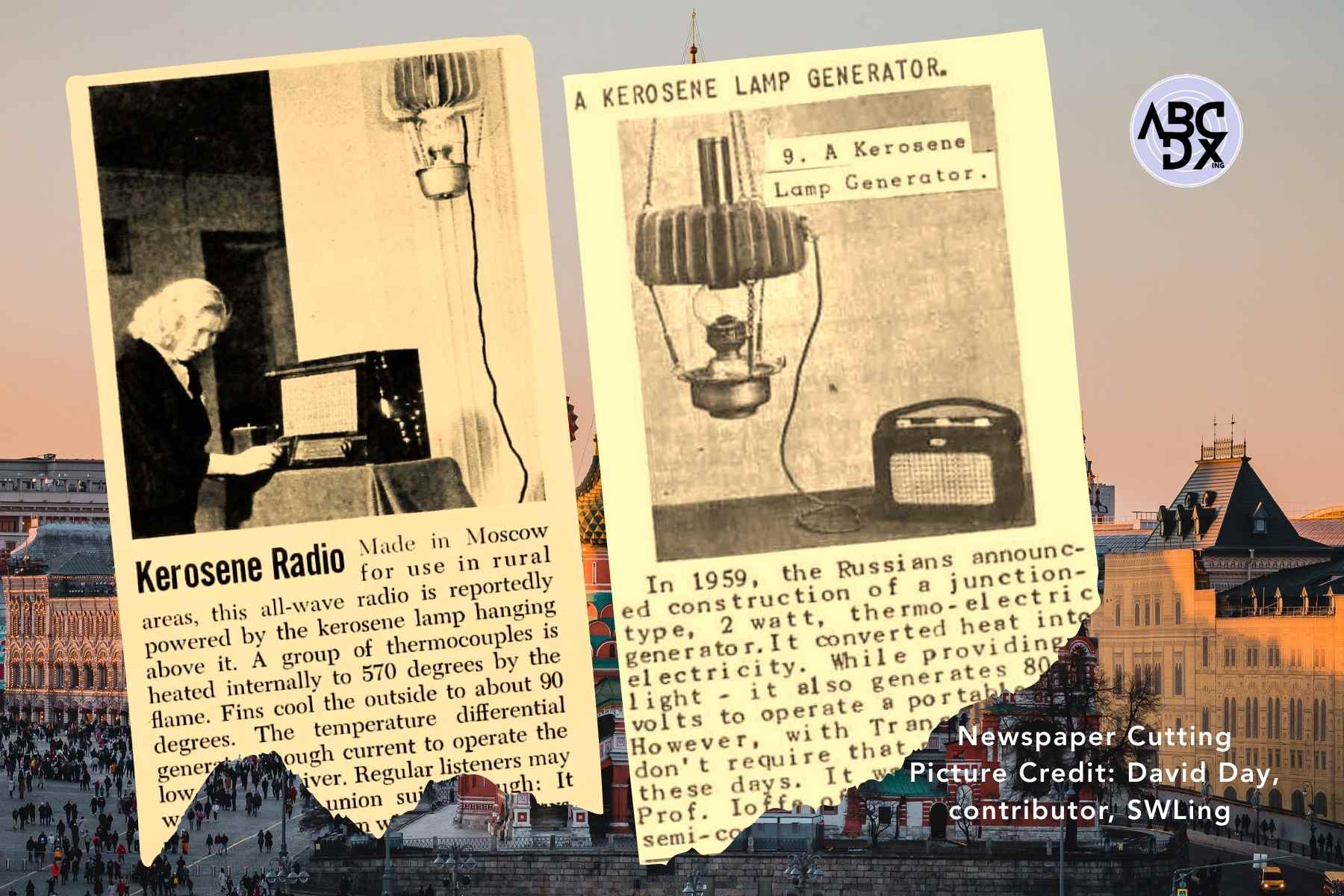Discover the incredible Soviet kerosene-powered radio, a unique gem for DXers and radio enthusiasts! Imagine a world without electricity, where the only connection to news and information comes through a radio that runs on kerosene. These radios were more than gadgets. They symbolized Soviet innovation during the Cold War. Similar thermoelectric tech powered WWII “Partisan’s Canteen” sets. Later, it fueled space missions and lighthouses via radioisotope generators. Safety concerns eventually phased out such designs.
Kerosene-Powered Radio: A Radio Revolution Born in Moscow
Imagine tuning into Radio Moscow without electricity. In the 1950s Soviet Union, this wasn't imagination but reality. The kerosene-powered radio became a lifeline for millions in rural areas, representing an ingenious solution to a critical communications challenge.
For radio enthusiasts and historians, these devices are more than just curiosities. They're fascinating examples of practical engineering meeting political necessity during the Cold War era. These ingenious devices brought news and music to Siberia, the rural USSR, and beyond. For DXers, this is a fascinating piece of radio history!
The Birth of a Necessity-Driven Invention
Post-World War II, the Soviet government faced a massive communications problem:
- Over 70% of rural households lacked electricity as late as 1955
- The Communist Party needed to distribute propaganda and information nationwide
- Standard battery-powered radios were expensive and impractical in remote areas
The solution emerged from Soviet engineering labs: a radio that could run on the heat from ordinary kerosene lamps, ubiquitous in villages across the USSR.
Key Figures in Development
Alexander Ostrovsky was a trailblazer in the thermoelectric applications, particularly in their integration into radio technology. His groundbreaking work laid the foundation for factories in Moscow and Leningrad. It began mass-producing these innovative radio sets under state orders. Interestingly, the designs of these radios drew inspiration from pre-war German thermoelectric experiments. This blend of past ingenuity with new technological advancements helped to reshape the industry.
Technical Marvel: Converting Heat to Sound
The radios worked through a clever thermoelectric generator (TEG) system:
- Kerosene Lamp Base - The radio sat directly on a lit lamp (typically the common "Bat" lantern)
- Heat Conversion - A bismuth-telluride thermopile converted flame heat into 2-3 volts of electricity
- Circuit Power - This small current powered specially designed low-voltage tubes (like the 1N3B)
- Signal Reception - A ferrite rod antenna picked up medium-wave broadcasts (200-500 kHz)
Remarkably, these radios required:
- No batteries
- No moving parts
- Just 30-60 minutes to warm up before the operation
How Did This Kerosene-Powered Radio Work?
The radio used a kerosene lamp’s heat to generate electricity. A thermocouple converts heat into power via the Peltier effect. The lamp heated one side to 300°C, while the cooling fins stayed at 30°C. This produced 1.2 volts for tube filaments. A vibrator power supply delivered 90 volts for circuits. One quart of kerosene powered 8–16 hours of listening. It also supported battery or electric operation.
Technical Brilliance
This 7-tube, 4-band superheterodyne receiver covered 175 kHz to 12.3 MHz. It spanned longwave to shortwave bands. A 5-inch loudspeaker and push-pull audio ensured clear sound. DXers could catch distant signals with ease. The design was rugged, perfect for harsh rural environments.
Why Was Kerosene-Powered Radio Created?
Post-World War II, the Soviet Union aimed to connect remote regions. Radio Moscow’s broadcasts spread news and propaganda. Kerosene radios reached areas without electricity, like Siberia and the Middle East. They were priced at $45 after subsidies and were called the “poor man’s radio.” Yet, kerosene scarcity limited their spread.
Mass Deployment Across the USSR
While exact production numbers remain undocumented in Soviet archives, multiple lines of evidence confirm these radios were widely distributed:
In the mid-20th century, the Soviet government initiated ambitious "radiofication" programs that mandated the distribution of radio sets to all unelectrified villages across the nation. This directive, issued by the Council of Ministers in 1953, aimed to connect remote communities to the larger world, bringing news and entertainment into every home.
Survivor accounts from the villages of Siberia and Central Asia paint a vivid picture of these radios as indispensable household items, often mentioned alongside kerosene lamps as essential tools for daily life. Residents fondly recall how these radios transformed their evenings, providing a window into distant events and cultures, fostering a newfound sense of connection.
Collectively, collectors and historians have uncovered a remarkable number of these radios, each bearing manufacturing stamps from 1955 to 1965. The consistent production markings suggest that these devices were created on an industrial scale, reflecting the Soviet commitment to ensuring that even the most isolated communities were not left in the dark but rather illuminated by the voices and stories carried through the airwaves.
The radios were deployed to:
- Siberian Collective Farms - For weather reports and work announcements
- Central Asian Nomads - In Kazakhstan and Kyrgyzstan
Arctic Outposts - Where cold temperatures disabled conventional batteries
Why this Radios Disappeared
By the late 1960s, kerosene radios had become a relic of the past, and two significant factors contributed to their obsolescence. The first was the advent of rural electrification, where Soviet power grids finally connected even the most remote areas, bringing electricity to places it had never reached before. The second factor was the transistor revolution. As technology advanced, affordable and portable radios, such as the popular Selga model, emerged on the market, seamlessly replacing the bulky kerosene radios. These developments marked a transformative era in communication accessibility, fundamentally changing how people interacted with the world around them.
Legacy and Modern Connections
Today, these radios represent:
- A fascinating chapter in appropriate technology history
- Inspiration for modern off-grid communication solutions
- Prized collectibles, with working models selling for 300−300−800
Did You Know? Some units had dual-fuel capability, working with gasoline or vegetable oil in emergencies!
Where to See One Today
- Moscow Polytechnic Museum - Original working displays
- Riga Radio Museum - Excellent Soviet-era collection
- Online Auctions - Occasionally appear on eBay and radio forums.
Why DXers Love Kerosene-Powered Radio
For radio enthusiasts, this radio is a DXing treasure. Its ability to catch distant shortwave signals amazed listeners. Today, these sets are rare collectibles. You might spot one on eBay or in museum archives. Some hobbyists even recreate them!
Fun Facts
- Exported to China and the Middle East.
- Inspired by 1930s British gas-jet radios.
- A quart of kerosene lasted up to 16 hours.
- Featured in Soviet propaganda efforts.
Join the DXing Adventure At ABCDX, we celebrate radio history. The kerosene-powered radio is a testament to human ingenuity. Share your thoughts below! Have you seen one? Want to hunt for this gem? Join our community to explore more DXing wonders.

